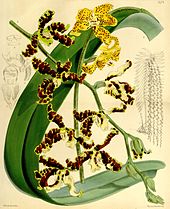Human uses of plants
Human uses of plants include both practical uses, such as for
In art, mythology, religion, literature and film, plants play important roles, symbolising themes such as fertility, growth, purity, and rebirth. In architecture and the decorative arts, plants provide many themes, such as Islamic arabesques and the acanthus forms carved on to classical Corinthian order column capitals.
Context
Practical uses
As food

Humans depend on plants for
In industry
Plants grown as
Structural materials and fibres from plants are used to construct dwellings and to manufacture clothing. Wood is used not only for buildings, boats, and furniture, but also for smaller items such as musical instruments, hand tools, and sports equipment. Wood is pulped to make paper and cardboard.[9] Cloth is often made from cotton, flax, ramie or synthetic fibres such as rayon and acetate derived from plant cellulose. Thread used to sew cloth likewise comes in large part from cotton.[10]
Plants are a primary source of basic
In medicine
Many hundreds of medicines are derived from plants, both traditional medicines used in
For chemicals
In gardening

Thousands of plant species are cultivated for aesthetic purposes as well as to provide shade, modify temperatures, reduce wind, abate noise, provide privacy, and prevent soil erosion. Plants are the basis of a multibillion-dollar per year tourism industry, which includes travel to historic gardens, national parks, rainforests, forests with colorful autumn leaves, and festivals such as Japan's[20] and America's cherry blossom festivals.[21]
There are also art forms specializing in the arrangement of cut or living plants, such as bonsai, ikebana, and the arrangement of cut or dried flowers. Ornamental plants have sometimes changed the course of history, as in tulipomania.[22]
In science

Basic biological research has often been done with plants. In
Scientific advances in genetic engineering led to developments in crops. Genetically modified crops introduce new traits to plants which they do not have naturally. These can bring benefits such as a decrease in the use of harmful pesticides, by building in qualities such as insect resistance and herbicide tolerance.[27]
Living structures
The ability of trees to graft is occasionally exploited by
Symbolic uses
In art

Plants appear in art, either to illustrate their botanical appearance,
Architectural designs resembling plants appear in the capitals of
In literature and film

Both real and fictitious plants play a wide variety of roles in
In mythology and religion

Plants figure prominently in
The
See also
- Floral emblem
- Plant epithet
References
- OCLC 652430995.
- .
- ^ "The Development of Agriculture". National Geographic. 2016. Retrieved 20 June 2016.
- ^ "Food and drink". Kew Gardens. Archived from the original on 28 March 2014. Retrieved 1 October 2017.
- ^ "Industrial Crop Production". Grace Communications Foundation. 2016. Retrieved 20 June 2016.
- ^ "INDUSTRIAL CROPS AND PRODUCTS An International Journal". Elsevier. Retrieved 20 June 2016.
- ISBN 978-1-4939-1447-0.
- ^ Sato, Motoaki (1990). Thermochemistry of the formation of fossil fuels (PDF). The Geochemical Society.
{{cite book}}:|work=ignored (help) - ISBN 978-3-527-30997-9.
- ^ "Natural fibres". Discover Natural Fibres. Archived from the original on 15 May 2019. Retrieved 20 June 2016.
- ^ "Chemicals from Plants". Cambridge University Botanic Garden. Archived from the original on 9 December 2017. Retrieved 20 June 2016. Note that the details of each plant and the chemicals it yields are described in the linked subpages.
- S2CID 9769230.
- PMID 15180577.
- ^ "Greek Medicine". National Institutes of Health, USA. 16 September 2002. Retrieved 22 May 2014.
- ISBN 9780199873982.
- ISBN 9781848580398.
- ^ Duke, S.O. (1990). Janick, J.; Simon, J.E. (eds.). "Natural pesticides from plants". Advances in New Crops: 511–517.
- ^ "Psychoactive Substances: A Guide to Ethnobotanical Plants and Herbs, Synthetic Chemicals, Compounds and Products" (PDF). Health Service Executive, Ireland. Retrieved 20 June 2016.
- ^ Long, Scott. "Natural Products -- Plants". South West Oklahoma State University. Archived from the original on 28 February 2014. Retrieved 20 June 2016.
- ISBN 978-0-8048-2056-1.
hanami
- ^ "History of the Cherry Blossom Trees and Festival". National Cherry Blossom Festival: About. National Cherry Blossom Festival. Archived from the original on 14 March 2016. Retrieved 22 March 2016.
- British Broadcasting Corporation. Retrieved 21 June 2016.
- ^ Blumberg, Roger B. "Mendel's Paper in English".
- ^ "BARBARA McCLINTOCK:A Brief Biographical Sketch". WebCite. Archived from the original on 27 September 2011. Retrieved 21 June 2016.
- ^ "About Arabidopsis". TAIR. Retrieved 21 June 2016.
- ^ "Engineering Life". NASA. Archived from the original on 2 April 2010. Retrieved 21 June 2016.
- S2CID 2094394.
- ^ Lewin, Brent (November 2012). "India's living Bridges". Reader's Digest Australia. pp. 82–89. Archived from the original on 16 November 2012.
- ^ "Living Root Bridge in Laitkynsew India". www.india9.com. Retrieved 22 February 2010.
- ^ "Living Root Bridges of Nagaland India – Nyahnyu Village Mon District | Guy Shachar". guyshachar.com. 16 April 2016. Retrieved 7 September 2017.
- ^ "Baduy Tribe". Ruby Mangunsong. 13 December 2015. Retrieved 7 September 2017.
- ^ Grundhauser, Eric. "West Sumatra, Indonesia Jembatan Akar". Atlasobscura.
- ^ Antheunisse, Max (2009). "About". Plant Illustrations. Retrieved 20 June 2016.
- ^ "Botanical Imagery in European Painting". Metropolitan Museum of Art. Retrieved 19 June 2016.
- ^ Raymond, Francine (12 March 2013). "Why botanical art is still blooming today". The Daily Telegraph. Retrieved 19 June 2016.
- ISBN 978-0-500-05100-9.
- ISBN 9780394509310.
- ^ "Plant motifs in Islamic art". Victoria and Albert Museum. 2011-03-31. Retrieved 19 June 2016.
- ISBN 978-1-134-95697-5.
- ISBN 978-0-300-19614-6.
- PMID 27251545.
- ^ "Top 10: evil plants from films". The Daily Telegraph. Retrieved 19 June 2016.[dead link]
- ^ The Fellowship of the Ring, I 12 "Flight to the Ford".
- ^ The Fellowship of the Ring, II 6 "Lothlórien".
- ^ a b The Return of the King, VI 9 "The Grey Havens".
- ^ The Fellowship of the Ring, I 6 "The Old Forest".
- ISBN 978-0-87338-883-2.
- ISBN 978-0-15-100561-1.
- ISBN 978-1-60473-094-4.
- ^ Cameron, James. "Avatar" (PDF). Avatar Screenings. Fox and its Related Entities. p. 25. Archived from the original (PDF) on 25 May 2010. Retrieved 9 February 2010.
- ^ "Poetry". Spirit of Trees. Retrieved 21 June 2016.
- ^ "Tree Poems". Poem Hunter. Retrieved 21 June 2016.
- ^ "Flower Poems". Poem Hunter. Retrieved 21 June 2016.
- ^ "Plants in Mythology". Myth Encyclopedia. Retrieved 20 June 2016.
- ^ Leitten, Rebecca Rose. "Plant Myths and Legends". Cornell University Liberty Hyde Bailey Conservatory. Retrieved 20 June 2016.
- doi:10.15181/ab.v15i1.28. Archived from the original(PDF) on 25 March 2012. Retrieved 21 August 2012.
- ^ Vīķe-Freiberga, Vaira (2005). "Saule". In Jones, Lindsay (ed.). Encyclopedia of Religion. Vol. 12 (2nd ed.). Thomson Gale. pp. 8131–8135.
- ISBN 978-0-19-811181-8.
- ISBN 978-0-203-40850-6.
- ^ "Barnacle Goose". The Medieval Bestiary. Retrieved 20 June 2016.
- JSTOR 3716844.
- ^ "Flora 1: Plants of Greek Myth". Theoi. Retrieved 20 June 2016.
- ^ Brewer, Ebenezer Cobham. Lotus tree. p. 526.
{{cite book}}:|work=ignored (help) - ^ Chisholm, Hugh, ed. (1911). "Moly". Encyclopædia Britannica. Vol. 18 (11th ed.). Cambridge University Press. p. 681. cites: Homer, Odyssey, x. 302–306.
- ^ John Gerard (1597). "Herball, Generall Historie of Plants". Claude Moore Health Sciences Library. Archived from the original on 2012-09-01. Retrieved 2016-09-26.
- S2CID 34302143.
- ISBN 978-954-739-682-1.
- ISBN 978-954-528-772-5.
- ^ Раденковић, Љубинко (2000–2001). Расковник у кругу сличних биљака (in Serbian). Slavic Gate. Archived from the original on 25 June 2010. Retrieved 24 August 2010.
- ISBN 978-1-118-01586-5.
- ISBN 978-0-19-289223-2.
